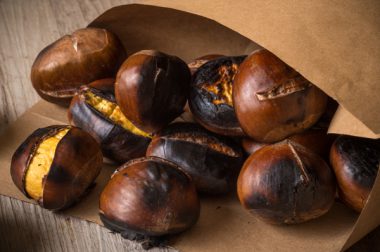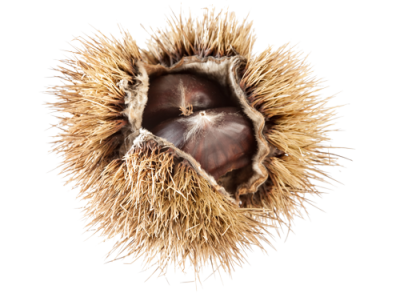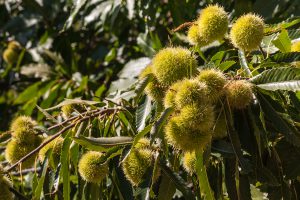Recipes we love
See all recipesChestnut soup with prawns
Chestnuts are very nourishing and this recipe is a meal in itself: serve it for instance with green ...
Boiled chestnuts
This is an easy, inexpensive recipe. If you don’t have the time, simply open a jar or can of peeled,...
Green bean clafoutis
A delicious way of starting a meal... or make it the centrepiece of the whole occasion! Green bean c...
HEALTH
BENEFITS
Chestnuts: gluten-free energy !
Chestnuts are low in fat but rich in carbohydrates. This makes them an ideal high-energy snack and flour made from chestnuts is a useful gluten-free alternative to traditional flours for those with coeliac disease.
Chestnuts are also :
- Rich in vitamin B9, which is important for cell renewal, crucial for the development of the fetus during pregnancy, and for growing children
- Rich in dietary fiber
- Rich in vitamin C, which is important for energy metabolism, maintaining the immune system during physical activity, the normal functioning of the nervous system, and helping to reduce fatigue
It also contains :
- Vitamin B1, which is important for energy metabolism, psychological functioning and the heart.
- Vitamin B2, which notably plays a role in energy metabolism, the normal functioning of the nervous system and maintaining healthy skin and eyesight
- Vitamin B6, which is mainly required for energy and protein metabolism, and the normal functioning of the immune system and the nervous system
NUTRITIONAL
COMPOSITION
WHEN IS THE RIGHT
TIME TO EAT CHESTNUTS?
In the autumn.
Chestnuts are in season from mid-September to the end of November.
VEGETABLE PATCH
OR URBAN BALCONY?
For optimum growth, chestnut enjoys sunny locations or partial shade in a deep, well-drained soil, and slightly acidic ground (pH less than 7). More growing tips.
CHOOSING
AND STORING CHESTNUTS
Choosing the best chestnuts :
Chestnuts should always be shiny, full, and not visibly damaged.
A tip for finding out if the chestnut is OK to use: Put chestnuts in a bowl of water before cooking. Discard any that float, as they’re probably hollow. Healthy fruits, which are heavier, don’t float.
Storing chestnuts :
- In the refrigerator: Seven to eight days maximum in the vegetable drawer. Never store at room temperature! They don’t do well in hot or humid conditions.
- Freezing: Peel and cook before freezing. Frozen chestnuts are ideal for grilling.
ANTI-WASTE TIPS
Do you think you have too many chestnuts and need to throw some away? Think again! Here are three useful anti-waste tips:
- Peel the chestnuts, cook them and then store them in your freezer. Then defrost and use as required.
- Make a soup. Boil the chestnuts in a vegetable broth, then add cream and mix together.
- Peel the chestnuts and serve in a salad, in a chicken wrap, as a side for a vegetable stir-fry, etc.
WHAT IS THE ENVIRONMENTAL IMPACT?
The Product Environmental Footprint (PET) tells us more! This is a score, calculated by Agribalyse*, which takes into account all of the stages of a vegetable’s life cycle: how it is grown, the impact of transport and processing, and so on. The lower the score, the lower the environmental impact.
- Chestnuts, raw: 0.5
- Chestnuts, grilled: 0.47
- Chestnut flour: 0.62
- Beefsteak, raw: 2.70
*Data taken from the Agribalyse database, which records the environmental score of food items. This unique score is an average of 16 indicators, calculated according to the European PEF methodology. It does not correspond to an environmental label or “eco-score”.
CO2 equivalent: For 100 g of raw chestnuts: 0.188 kg of CO2e, which is the same as 7 g of raw beefsteak.
TIPS
AND TRICKS
How to prepare chestnuts :
They have to be peeled twice! Chestnuts require hard work! The outer shell needs to be removed, as well as the thin inner skin, which is bitter.
Using a very sharp knife, pierce the round part of the chestnut to the inner layer and boil for three to five minutes.
Tip for removing the outer shell: Adding a tablespoon of oil to the water softens the shell and makes it easier to peel off.
Tip for removing the inner layer: Remove the outer shell, and then put the chestnuts in the microwave for one minute at full power. Roll the chestnuts between your hands (be careful not to burn yourself!), and then the inner skin should come off easily.
How do you cook chestnuts?
They should be pierced before frying, cooking in the oven, or on the barbecue to prevent them from bursting. Once cooked, they should open easily.
Cooking instructions:
- 20 min: In the frying pan, barbecue, or oven
- 15 min: In water
- 10 min: In the microwave
Chestnuts go well with :
Chestnuts go equally well with sweet and savory dishes. It’s also the star of Christmas dishes. It goes perfectly with poultry (chicken, guinea fowl, etc.) and game, foie gras, dried meats, ripe cheeses or goat’s cheese, fish, cream, vanilla, chocolate, apples, zucchini, pumpkins, or mushrooms, which is a particularly delicious combination.
Recipe idea: Grilled or roast chestnuts are wonderful as an aperitif with drinks. Lightly salted, they have four to five times fewer calories than the usually served peanuts, and ten times less fat and salt, and also make an original dish!
CAN EVERYONE
EAT THEM?

Young children
Chestnuts shouldn’t be given to infants under the age of 12 months. They are gluten-free and can be served as a purée or creamed with yoghurt or fromage frais. They are also very good on a slice of bread on in a soup.
And everyone else
The levels of complex carbohydrates (starch), potassium, and magnesium make chestnuts a particularly attractive option for sportspeople and everyone with an active lifestyle. They’re also very filling, which makes them the ideal snack for everyone!
See plenty of other tips for encouraging children to eat vegetables
WHERE DO THEY COME FROM?
ORIGINS AND VARIETIES
Origins
China is the biggest producer in the world, followed by Europe (Turkey, Italy, Greece, and France). The Greeks are the biggest consumers of chestnuts in the world.
Varieties
There are several chestnut varieties (Dorée de Lyon, Herria, Vignols, Naples, Turin, etc.), generally distinguished by region of origin, taste, color, and size.
Sweet chestnuts or horse chestnuts: what’s the difference? It’s confusing!
When we talk about chestnuts as a foodstuff, what we really mean are sweet chestnuts – not to be confused with horse chestnuts, which are poisonous! Here are three ways to distinguish between sweet and horse chestnuts:
- The burrs of sweet chestnuts are brown and bristly, while those of horse chestnuts are green and thick, with short, widely spaced spikes.
- The fruit: the horse chestnut is often bigger and rounded, while the sweet chestnut is smaller, flattened and triangular.
- Horse chestnuts are found in urban area, while sweet chestnuts grow in the forest. The leaves of the former are palm-shaped; those of the latter are more simple, and elongated.



 Onions
Onions  Dandelion greens
Dandelion greens  Vegetable garden: growing tomato
Vegetable garden: growing tomato 










